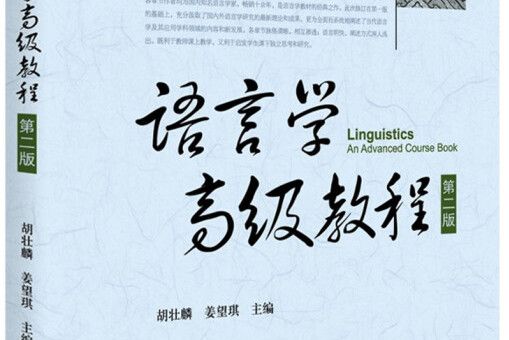《語言學高級教程(第二版)》是2015年北京大學出版社出版的圖書,作者是胡壯麟、姜望琪。
基本介紹
- 書名:語言學高級教程(第二版)
- 作者:胡壯麟、姜望琪
- 出版社:北京大學出版社
- 出版時間:2015年7月1日
- 裝幀:平裝
- ISBN:9787301258255
編輯推薦,內容簡介,圖書目錄,作者簡介,
編輯推薦
本《教程》自2002年出版以來,受到廣大教師和學生的廣泛歡迎,贏得了廣泛的讚譽,為我國語言學事業做出巨大的貢獻。該書是在《語言學教程》的基礎上,,將語言學中難度較大、理論性較強的內容作專門的討論,以供研究生教學使用。。但是,近10多年來,語言學的發展又取得了長足的進展,新的成果急需補充。有鑒於此,主編胡壯麟先生及一批中青年語言學家對教材做了修訂。修訂版聽取了在第一線使用本書的老師們的意見,對有些意義不大的內容作了刪除或刪節,對十餘年來語言學領域中的新進展作了充分反映。
內容簡介
《語言學高級教程》第一版出版於2002年。隨著歲月的流逝,有些內容逐漸陳舊,不再適應讀者的需要。為此,我們從2011年秋天開始籌劃該教程的修訂。我們聯繫了各位作者,徵求了修訂意見,確定了修訂方案。為了不增加讀者的負擔,這次修訂的總原則是一般不增加篇幅,增添新內容,因而要相應地刪減部分舊內容。
在各位作者的努力下,2013年5月完成修訂,大多數章節都有一些改動。除了改正一些錯誤以外,變動比較大的是,原來的第二章(Phonetics)和第三章(Phonology)被合併成了一章,縮減了語音學的一些內容,更名為Phonological Analysis;第七章Linguistic Comparison(原第八章)增加了對比語言學一節;第九章(原第十章Psycholinguistics)改成了Cognitive Linguistics,以反映當代語言學新近的發展;第十章Pragmatics(原第十一章)刪減了一些內容,增加了一個新小節;第十二章Computational Linguistics(原第十三章)刪除了兩個小節,充實了一個小節;原第十五章整章刪除。
圖書目錄
Chapter 1Linguistics—A Pilot Science
1.1Why Study Linguistics?
1.2What Is Language?—Defining the Object of Study
1.3Origin of Language
1.4Design Features of Language
1.5Animal Communication Systems, Gesture and
Other Language Forms
1.6Perspectives of Language Studies
1.7Functions of Language
1.8Important Distinctions in Linguistics
1.9Data of Linguistics
1.10Status and Prospect of Linguistics
Chapter 2Phonological Analysis
2.1Transcribing Speech Sounds
2.2Consonants and Vowels
2.3Phonemic vs. Phonetic Transcriptions
2.4Distinctive Features and Rule Representation
2.5Suprasegmentals and Feature Geometry
2.6Optimality Theory
2.7Conclusion
Chapter 3Morphology
3.1Morphemes, Morphs and Allomorphs
3.2Classification of Morphemes
3.3Morphemization
3.4Allomorphy
3.5Word, Wordform and Lexeme
3.6Morphology and Wordformation
3.7Approaches and Problems
Chapter 4Generative Syntax
4.1Generative Grammar: Some Basic Assumptions
4.2Phrase Structure Rules
4.3Projection from Lexicon
4.4The Minimalist Approach
Chapter 5Functional Syntax
5.1Vilém Mathesius
5.2Frantiek Dane
5.3Michael Halliday
5.4Summary
Chapter 6Semantics
6.1Introduction
6.2Meanings of “Meaning”
6.3The Referential Theory
6.4Sense Relations
6.5Componential Analysis
6.6Sentence Meaning
Chapter 7Linguistic Comparison
7.1Introduction
7.2Comparative and Historical Linguistics
7.3Typological Comparison
7.4Contrastive Linguistics
Chapter 8Language, Culture, and Society
8.1Introduction
8.2Language and Culture
8.3Language and Society
8.4Sociolinguistics and Language Teaching
8.5Summary
Chapter 9Cognitive Linguistics
9.1Introduction
9.2Cognitive Abilities and Cognitive Processes
9.3Cognitive Semantics
9.4Cognitive Grammar
Chapter 10Pragmatics
10.1Introduction
10.2Speech Act Theory
10.3The Classical Theory of Implicature
10.4PostGricean Theories
10.5Recent Developments in Pragmatics
Chapter 11Issues of Stylistics
11.1Introduction
11.2Style and Stylistics
11.3Style as Rhetoric: The Initial Stage of Stylistics
11.4One Style or Several Styles?
11.5Aspects of Style: The Writerstyle as Writer’s
Individual/Personal Singularities
11.6Aspects of Style: The Textstyle as Linguistic
Sameness (Structural Equivalence)
11.7Aspects of Style: The Textstyle as Linguistic
Difference (Deviation or Foregrounding)
11.8Aspects of Style: The Readerstyle
as Reader’s Response
11.9Aspects of Style: The Context:
Style as Function
11.10Aspects of Style: The Meaning:
Style as Meaning Potential
11.11Concluding Remarks: Linguistics,
Literary Criticism, and Stylistics
Chapter 12Computational Linguistics
12.1What is Computational Linguistics?
12.2Machine Translation
12.3Corpus Linguistics
12.4Information Retrieval
12.5Looking into the Future
Chapter 13Second Language Acquisition
13.1Introduction
13.2The Role of Internal Mechanisms
13.3The Role of Native Language
13.4Input, Interaction and Output
13.5Nonlanguage Influences
13.6Summary
Chapter 14Modern Theories and Schools of Linguistics
14.1The Beginning of Modern Linguistics
14.2The Prague School and the Copenhagen School
14.3The London School
14.4Halliday and SystemicFunctional Grammar
14.5American Structuralism
14.6Chomsky and TransformationalGenerative Grammar
14.7Revisionist/Rebellious Theories
14.8Concluding Remarks
作者簡介
本教材主編胡壯麟先生是著名語言學家、北京大學英語系資深教授、系統功能語言學的代表學者。本教材參編者是北京大學,上海交通大學等的優秀學者。他們不僅在各自的學術領域具有深厚的理論基礎,同時具有豐富的教學實踐經驗。

